Awareness of potential toxins that may pose a threat to our feline companions is a crucial aspect of responsible pet ownership. When it comes to daisies, a common flower found in many households, understanding their impact on cat health is essential.
A veterinarian's perspective sheds light on the risks associated with daisies and how they can affect our beloved cats. Stay tuned to discover the intricacies of daisy toxicity and what steps you can take to keep your furry friend safe and healthy.
Key Takeaways
- Daisy toxicity in cats can cause vomiting, diarrhea, and coordination issues.
- Immediate veterinary attention is crucial for severe poisoning cases.
- Prevention involves keeping daisies out of reach and supervising cats around plants.
- Treatment includes fluid therapy, medication, and a bland diet for mild cases.
Daisy Toxicity in Cats
Daisies pose a potential threat to cats due to the presence of toxins like lactones, pyrethrins, and sesquiterpene. These toxins can lead to various health issues if ingested by our feline companions.
Cats, known for their curious nature, may nibble on daisies either indoors or outdoors, unknowingly exposing themselves to these harmful substances. As responsible pet owners, it's essential to be vigilant and proactive in safeguarding our cats from such dangers.
Understanding the risks associated with daisy toxicity is crucial for providing a safe environment for our beloved pets. By being aware of the potential threats daisies pose to our cats, we can take appropriate measures to prevent accidental exposure and ensure their well-being.
Symptoms of Daisy Poisoning
When a cat is poisoned by daisies, it exhibits a range of symptoms indicative of toxin ingestion. These symptoms include:
- Vomiting: Cats may experience frequent episodes of vomiting after ingesting daisies.
- Diarrhea: The ingestion of daisies can lead to watery or bloody diarrhea in affected cats.
- Hypersalivation: Excessive drooling may occur as a result of daisy poisoning.
- Lack of coordination: Cats may show signs of unsteadiness or lack of coordination due to the toxins present in daisies.
These symptoms serve as crucial indicators that prompt the need for immediate veterinary attention to address the poisoning effectively.
Importance of Veterinary Attention
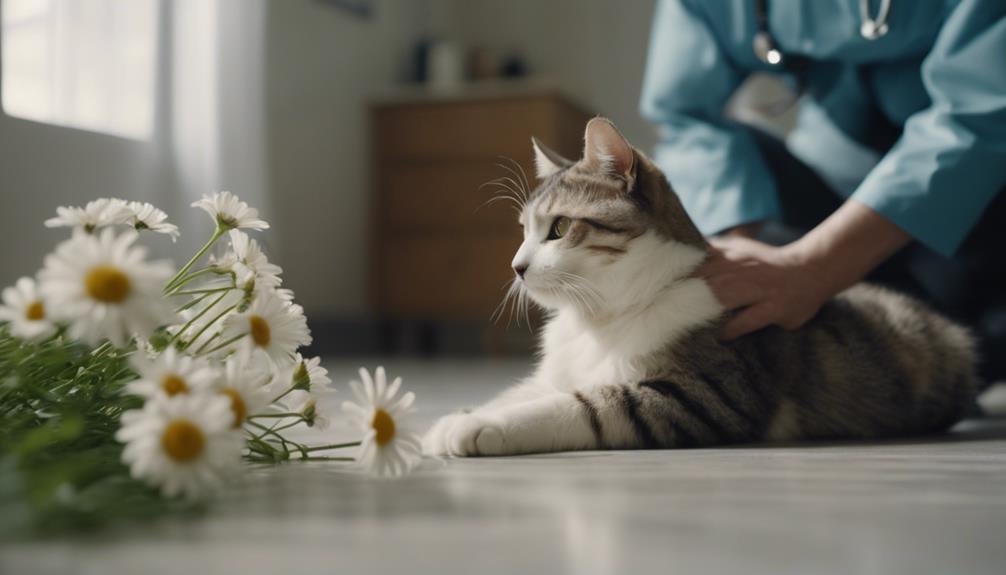
Seeking prompt veterinary attention is paramount when a cat shows symptoms of daisy poisoning to ensure effective treatment and recovery. Cats can experience severe complications from ingesting daisies, such as vomiting, diarrhea, and lack of coordination, which necessitate immediate professional intervention. Veterinarians are equipped to assess the severity of poisoning, provide appropriate care, and administer necessary treatments like fluid therapy and medication.
Delaying veterinary attention can exacerbate the cat's condition, potentially leading to more serious health issues. Therefore, if you suspect your cat has consumed daisies or is displaying symptoms of poisoning, do not hesitate to contact your veterinarian for guidance and assistance. Your quick action could be instrumental in safeguarding your cat's well-being and facilitating a speedy recovery.
Treatment for Daisy Poisoning
In cases of daisy poisoning in cats, prompt veterinary intervention is essential to administer appropriate treatment and ensure the cat's recovery. Treatment for daisy poisoning typically involves the following steps:
- Physical Examination: The vet will conduct a thorough physical exam to assess the cat's overall health and determine the extent of poisoning.
- Fluid Therapy: Fluid therapy may be administered to help flush out toxins from the cat's system and prevent dehydration.
- Medication: Medication to protect the stomach lining and alleviate symptoms like vomiting and diarrhea may be prescribed.
- Monitoring: Close monitoring of the cat's progress is crucial to ensure a successful recovery and address any complications promptly.
Resolution of Mild Cases
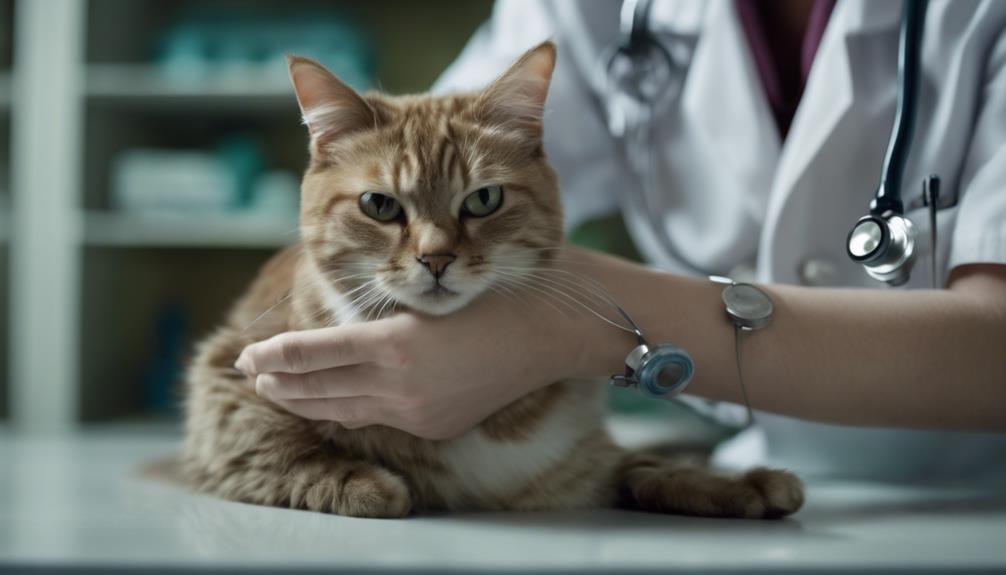
Prompt veterinary intervention plays a crucial role in ensuring the successful resolution of mild cases of daisy poisoning in cats. Mild cases of daisy poisoning typically resolve within a few days with proper care and management. Here is a simple guide to help you navigate through the resolution process:
| Resolution Steps | Description |
|---|---|
| Veterinary Consultation | Seek advice from a veterinarian promptly. |
| Bland Diet | Feed your cat boiled chicken or turkey with rice. |
| Monitoring | Keep a close eye on your cat's symptoms and behavior. |
| Follow-Up Check-Up | Schedule a follow-up appointment to ensure recovery progress. |
Preventing Daisy Poisoning
To safeguard your feline companions from potential daisy poisoning, proactive measures should be taken to restrict their access to these toxic flowers. Here are some essential steps to prevent daisy poisoning in cats:
- Reference ASPCA's list of toxic plants: Familiarize yourself with plants that are harmful to cats.
- Keep daisies out of reach: Place daisies in areas inaccessible to cats, such as high shelves or behind barriers.
- Consider fencing off toxic plants: Create physical barriers to prevent cats from coming into contact with toxic flowers in gardens.
- Supervise cats closely: Monitor your cats when they are outdoors near plants, ensuring they do not ingest any potentially harmful flowers.
Reference ASPCA Toxic Plants List
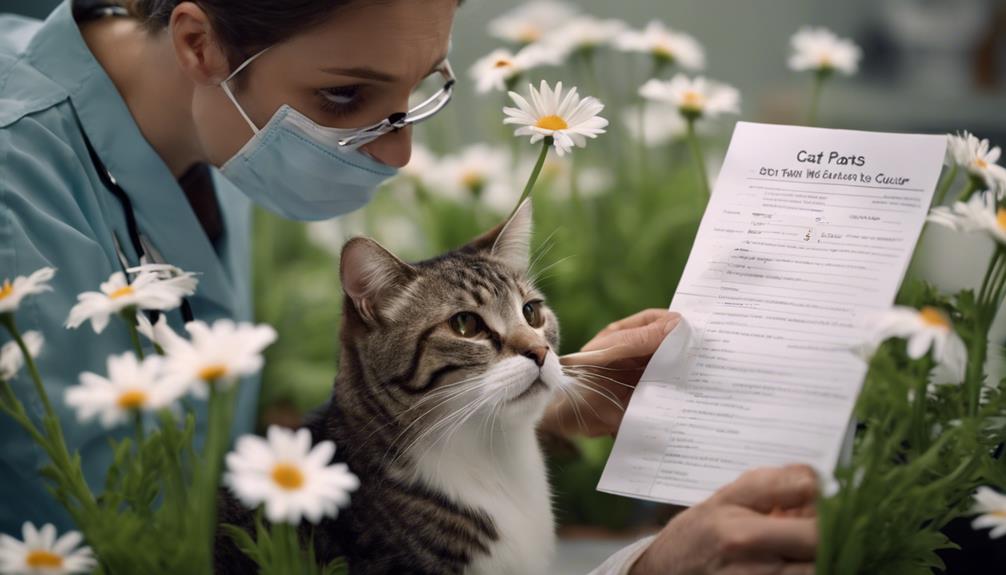
Utilizing the ASPCA's comprehensive list of toxic plants is essential for pet owners seeking to safeguard their animals from potential plant-related hazards. Being aware of which plants pose a risk can help prevent accidental ingestion by pets. Below is a table listing some common toxic plants to be cautious of:
| Toxic Plants | Potential Effects |
|---|---|
| Lilies | Kidney failure |
| Sago Palm | Liver damage |
| Autumn Crocus | Organ damage |
| Oleander | Cardiac issues |
Keeping Daisies Out of Reach
When safeguarding your feline companions against potential daisy poisoning, it is imperative to ensure that daisies are kept out of reach. Here are some practical tips to help you achieve this:
- Place daisies in hanging planters or high shelves to prevent cats from accessing them.
- Opt for cat-friendly indoor plants to divert their attention away from toxic flowers.
- Use deterrent sprays or natural repellents around daisies to discourage cats from approaching them.
- Create designated play areas with cat-safe plants to keep your furry friends entertained and away from harmful flowers.
Fencing Off Toxic Plants
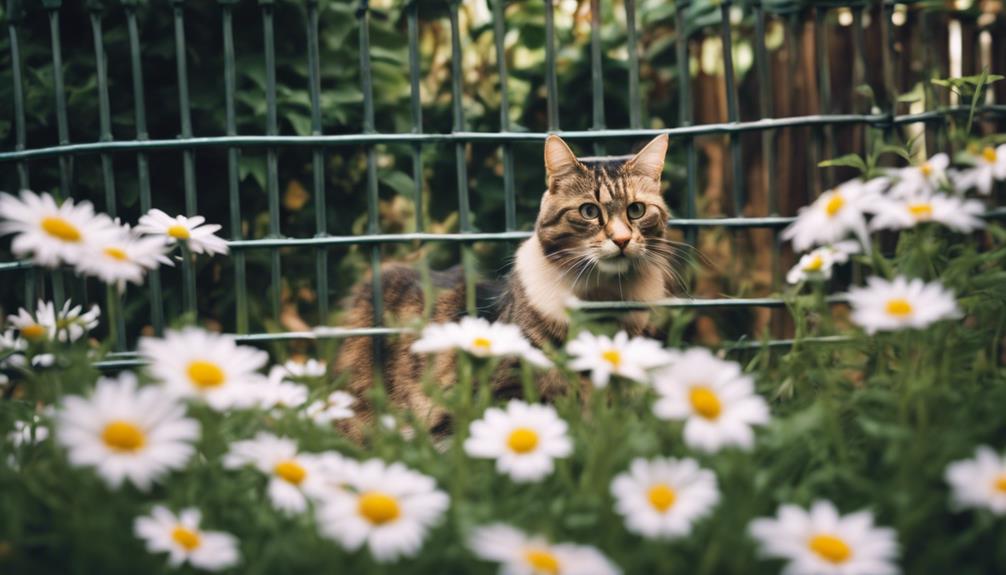
Implementing physical barriers around toxic plants is an effective method to prevent cats from accessing and potentially ingesting harmful substances. Fencing off toxic plants in the garden can create a safe zone where cats are unable to reach or nibble on dangerous flora.
This protective measure acts as a reliable deterrent, keeping curious felines away from potentially toxic flowers like daisies. By creating a barrier, such as a low fence or plant netting, pet owners can provide a secure environment for their cats to explore without the risk of exposure to hazardous plants.
Ensuring that these barriers are sturdy and properly installed is essential in safeguarding pets from accidental ingestion of toxic plant material.
Supervising Cats Outdoors
To ensure the safety of cats around toxic plants like daisies, it is essential for pet owners to closely supervise their feline companions when outdoors.
- Stay Vigilant: Keep a watchful eye on your cat to prevent them from wandering near potentially harmful plants.
- Create Safe Boundaries: Utilize cat enclosures or leashes to limit access to areas with toxic plants.
- Provide Enrichment: Offer stimulating toys and activities to keep your cat entertained and less likely to investigate dangerous flora.
- Regular Check-ins: Take breaks to inspect the outdoor environment for any new plants or hazards that could pose a threat to your cat's well-being.
Related Articles on Pet Safety
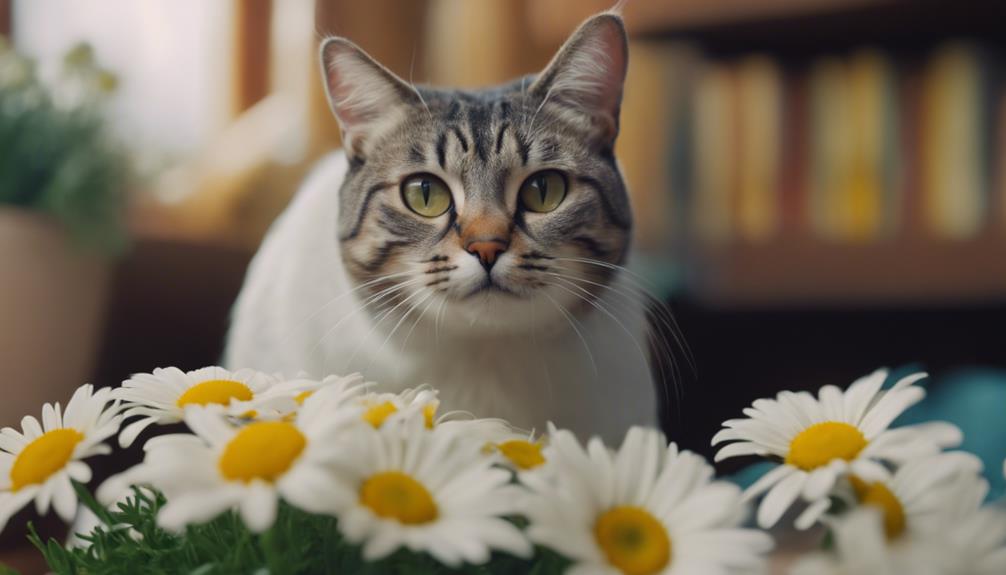
Understanding pet safety is crucial for responsible pet ownership, and exploring related articles on the topic can provide valuable insights for safeguarding your furry companions. Here are some related articles that can enhance your knowledge and help you create a safe environment for your pets:
| Spring Pet Safety Tips | Risks of Toxic Flowers | Toxic Foods to Avoid |
|---|---|---|
| – Secure your home for pets during spring. | – Learn about flowers like roses and hydrangeas that can be harmful to your cats. | – Understand which foods like garlic and poinsettias are toxic to cats and dogs. |
| – Tips on creating a safe environment for pets. | – Identify other toxic plants to keep away from your furry friends. | – Know the dangers of certain human foods for your pets. |
| – How to monitor pets for potential dangers. | – Prevent accidental ingestion of toxic flowers. | – Implement strategies to keep your pets safe from harmful foods. |
Risks of Toxic Flowers
What dangers do toxic flowers pose to the health of cats and other pets?
- They can cause gastrointestinal upset such as vomiting and diarrhea.
- Some toxic flowers may lead to more severe symptoms like organ damage or failure.
- Ingestion of certain toxic flowers can result in neurological issues or respiratory distress.
- Poisoning from toxic flowers can be fatal if not treated promptly.
It is crucial for pet owners to be aware of the potential risks associated with toxic flowers and take proactive measures to prevent their pets from accessing these plants. By understanding the dangers posed by toxic flowers and implementing appropriate safety measures, pet owners can help ensure the well-being and health of their beloved companions.
Plant Safety Awareness
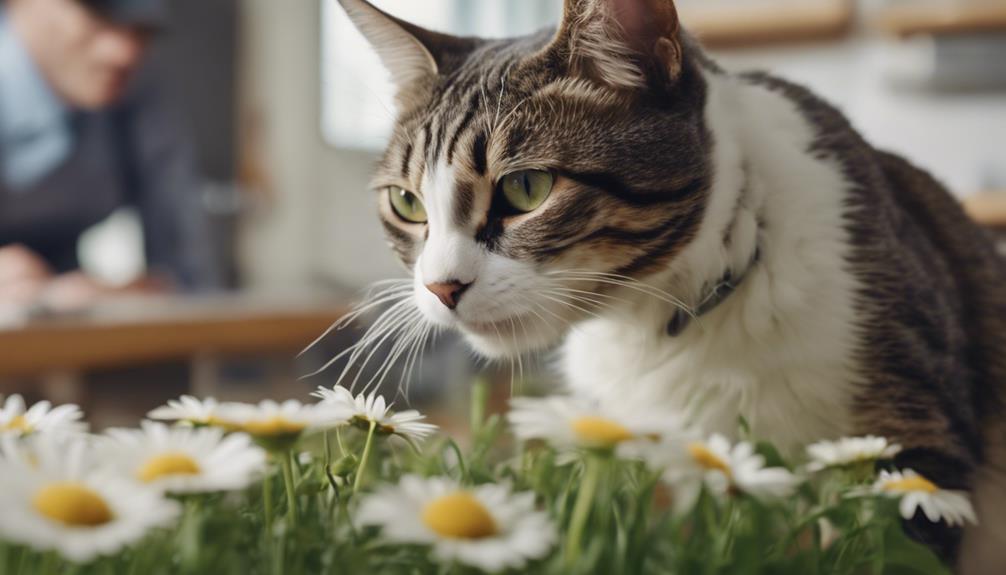
As pet owners navigate the risks associated with toxic flowers, cultivating a heightened awareness of plant safety becomes imperative to safeguard the well-being of their beloved companions. By referencing resources like the ASPCA list of toxic plants, pet owners can identify and eliminate potential hazards such as daisies, hydrangeas, and poinsettias from their surroundings.
Taking proactive measures like keeping toxic plants out of reach, fencing off garden areas, and closely supervising pets outdoors can prevent accidental ingestion and potential poisoning incidents. Understanding the risks associated with certain flowers and foods, and monitoring pets for any signs of illness, are crucial steps in creating a safe environment for our furry friends.
Stay informed and vigilant to ensure the health and happiness of your pets.
Frequently Asked Questions
Can Daisies Cause Long-Term Health Issues in Cats if Ingested?
Daisies can cause serious health issues in cats if ingested due to their toxic compounds. Immediate veterinary attention is necessary to prevent long-term consequences. Awareness of toxic plants, like daisies, and prompt treatment are crucial for cat safety.
Are There Any Alternative Treatment Options for Daisy Poisoning in Cats?
Alternative treatments for daisy poisoning in cats may include activated charcoal to absorb toxins, supportive care to manage symptoms, and specific antidotes if available. Consult a veterinarian promptly for tailored treatment options based on the severity of poisoning.
How Quickly Do Symptoms of Daisy Poisoning Typically Manifest in Cats After Ingestion?
Symptoms of daisy poisoning in cats typically manifest within hours of ingestion. Vomiting, diarrhea, hypersalivation, lack of coordination, and bloody stool are common signs. Immediate veterinary attention is vital for a prompt diagnosis and treatment.
Are There Any Specific Breeds of Cats That Are More Susceptible to Daisy Toxicity?
Certain cat breeds like Siamese, Burmese, and Abyssinian may be more susceptible to daisy toxicity due to genetic predispositions. However, all cats should be kept away from daisies to prevent potential poisoning incidents. Vigilance and prevention are key.
Can Daisy Poisoning in Cats Be Mistaken for Other Common Illnesses or Conditions?
Daisy poisoning in cats can mimic common illnesses, leading to misdiagnosis. Symptoms like vomiting, diarrhea, and lack of coordination may resemble other conditions. Prompt veterinary evaluation is vital to differentiate and initiate necessary treatment.
Conclusion
In conclusion, understanding the risks of daisy toxicity in cats is essential for ensuring the health and safety of our feline companions. Recognizing the symptoms, seeking veterinary attention promptly, and implementing preventive measures can help mitigate the dangers associated with daisies and other toxic flora.
By staying informed and taking proactive steps to protect our cats from potential harm, we can create a secure environment that promotes their well-being.




